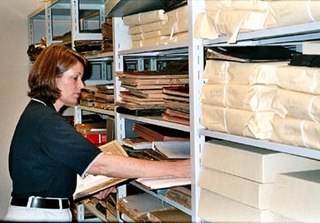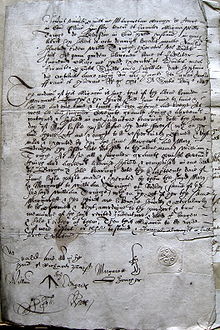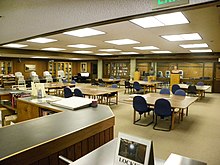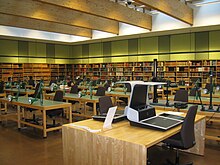
The National Archives and Records Administration (NARA) is an independent agency of the United States government within the executive branch, charged with the preservation and documentation of government and historical records. It is also tasked with increasing public access to those documents that make up the National Archives. NARA is officially responsible for maintaining and publishing the legally authentic and authoritative copies of acts of Congress, presidential directives, and federal regulations. NARA also transmits votes of the Electoral College to Congress. It also examines Electoral College and constitutional amendment ratification documents for prima facie legal sufficiency and an authenticating signature.

An archive is an accumulation of historical records or materials – in any medium – or the physical facility in which they are located.

Digitization is the process of converting information into a digital format. The result is the representation of an object, image, sound, document, or signal obtained by generating a series of numbers that describe a discrete set of points or samples. The result is called digital representation or, more specifically, a digital image, for the object, and digital form, for the signal. In modern practice, the digitized data is in the form of binary numbers, which facilitates processing by digital computers and other operations, but digitizing simply means "the conversion of analog source material into a numerical format"; the decimal or any other number system can be used instead.

An archivist is an information professional who assesses, collects, organizes, preserves, maintains control over, and provides access to records and archives determined to have long-term value. The records maintained by an archivist can consist of a variety of forms, including letters, diaries, logs, other personal documents, government documents, sound or picture recordings, digital files, or other physical objects.
The Archives Hub is a Jisc service, and is freely available to all. It provides a cross-search of descriptions of archives held across the United Kingdom, in over 320 institutions, including universities, colleges, specialist repositories, charities, businesses and other institutions. It includes over 1,000,000 descriptions of archive materials on all manner of subjects, which represents over 30,000 archive collections. It also describes content available through topic-based websites, often created as a result of digitisation projects.
Encoded Archival Description (EAD) is a standard for encoding descriptive information regarding archival records.

Archival science, or archival studies, is the study and theory of building and curating archives, which are collections of documents, recordings, photographs and various other materials in physical or digital formats.
ArchiveGrid is a collection of over five million archival material descriptions, including MARC records from WorldCat and finding aids harvested from the web. It contains archival collections held by thousands of libraries, museums, historical societies, and archives. Contribution to the system is available to any institution. Most of the contributions are from United States based institutions, but many other countries are represented, including Canada, Australia, and the United Kingdom. ArchiveGrid is associated with OCLC Research and helps to advance their goals of making archival collections and materials easier to find. ArchiveGrid is described as "the ultimate destination for searching through family histories, political papers, and historical records held in archives around the world."
A finding aid, in the context of archival science and archival research, is an organization tool, a document containing detailed and processed metadata and other information about a specific collection of records within an archive. Finding aids often consist of a documentary inventory and description of the materials, their source, and their structure. The finding aid for a fonds is usually compiled by the collection's entity of origin, provenance, or by an archivist during archival processing, and may be considered the archival science equivalent of a library catalog or a museum collection catalog. The finding aid serves the purpose of locating specific information within the collection. The finding aid can also help the archival repository manage their materials and resources.
Archival processing is the act of surveying, arranging, describing, and performing basic preservation activities on the recorded material of an individual, family, or organization after they are permanently transferred to an archive. A person engaging in this activity is known as an archival processor, archival technician, or archivist.
In archival science and archive administration, appraisal is a process usually conducted by members of the record-holding institution in which a body of records is examined to determine its value for that institution. It also involves determining how long this value will last. The activity is one of the central tasks of an archivist, to determine the archival value of specific records. When it occurs prior to acquisition, the appraisal process involves assessing records for inclusion in the archives. In connection with an institution's collecting policy, appraisal "represents a doorway into the archives through which all records must pass". Some considerations when conducting appraisal include how to meet the record-granting body's organizational needs, how to uphold requirements of organizational accountability, and how to meet the expectations of the record-using community.
Describing Archives: A Content Standard (DACS) is a standard used for describing materials in archives. First adopted by the Society of American Archivists (SAA) in March 2004, DACS was updated with a Second Edition in 2013. DACS is broken down into a set of rules used in crafting archival descriptions, and guidelines for creating authority records in archives.

A digital library is an online database of digital objects that can include text, still images, audio, video, digital documents, or other digital media formats or a library accessible through the internet. Objects can consist of digitized content like print or photographs, as well as originally produced digital content like word processor files or social media posts. In addition to storing content, digital libraries provide means for organizing, searching, and retrieving the content contained in the collection. Digital libraries can vary immensely in size and scope, and can be maintained by individuals or organizations. The digital content may be stored locally, or accessed remotely via computer networks. These information retrieval systems are able to exchange information with each other through interoperability and sustainability.

Smithsonian Libraries and Archives is an institutional archives and library system comprising 21 branch libraries serving the various Smithsonian Institution museums and research centers. The Libraries and Archives serve Smithsonian Institution staff as well as the scholarly community and general public with information and reference support. Its collections number nearly 3 million volumes including 50,000 rare books and manuscripts.
In the context of libraries and archives, an inventory refers to a detailed list or record of the items, materials, or resources held within a collection.
A memory institution is an organization maintaining a repository of public knowledge, a generic term used about institutions such as libraries, archives, heritage institutions, aquaria and arboreta, and zoological and botanical gardens, as well as providers of digital libraries and data aggregation services which serve as memories for given societies or mankind. Memory institutions serve the purpose of documenting, contextualizing, preserving and indexing elements of human culture and collective memory. These institutions allow and enable society to better understand themselves, their past, and how the past impacts their future. These repositories are ultimately preservers of communities, languages, cultures, customs, tribes, and individuality. Memory institutions are repositories of knowledge, while also being actors of the transitions of knowledge and memory to the community. These institutions ultimately remain some form of collective memory. Increasingly such institutions are considered as a part of a unified documentation and information science perspective.

The National Recording Preservation Plan is a strategic guide for the preservation of sound recordings in the United States. It was published in December 2012 by the Council on Library and Information Resources (CLIR) and the National Recording Preservation Board of the Library of Congress. The plan was written by a community of specialists, but is prominently credited to Brenda Nelson-Strauss, Alan Gevinson and Sam Brylawski
"More Product, Less Process: Revamping Traditional Archival Processing" is a 2005 archival science article written by Mark A. Greene and Dennis Meissner that first appeared in the Fall/Winter 2005 issue of The American Archivist. The paper argues that traditional archival processing is too slow, and advocates for the use of minimal processing in order to reduce backlogs and provide access to archival collections as quickly as possible. The ideology presented in the article, abbreviated as MPLP, has since been widely adopted in modern archival theory with subsequent praise directed primarily towards the ability to increase user accessibility without prohibiting the option for future processing.
Elizabeth Yakel is an archivist, researcher, and educator in information science. Yakel is known for work advancing archival practice, the use of primary sources in archives education, studies of data reuse practices, and digital curation. Yakel is the senior associate dean for academic affairs and a professor at the University of Michigan School of Information, where she has been on the faculty since 2000. She is the former coordinator of the Preservation of Information specialization in the Master of Science in Information program and teaches in the Archives and Record Management area. She specializes in digital archives and digital preservation and has developed five such graduate level courses at UM, including "Economics of Sustainable Digital Information" and "Practical Engagement Workshop in Digital Preservation."
Social Networks and Archival Context (SNAC) is an online project for discovering, locating, and using distributed historical records in regard to individual people, families, and organizations.












